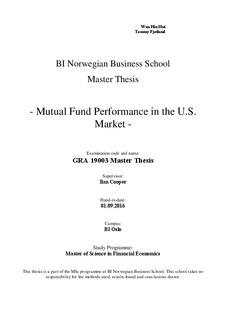Mutual Fund Performance in the U.S. Market
Master thesis
Permanent lenke
http://hdl.handle.net/11250/2443062Utgivelsesdato
2016Metadata
Vis full innførselSamlinger
- Master of Science [1621]
Sammendrag
This paper examines whether actively managed U.S. mutual equity funds exhibit any statistical persistence in mutual fund performance by applying three different methods. The backbone for the methods is the sorting procedure that creates ten equally weighted portfolios based on lagged one-year simple returns of the mutual funds and rank them accordingly from best to worst. The ranked portfolios are further implemented in three different holding strategies; they rebalance every three, six and twelve months. The first method obtains risk-adjusted returns and alphas from all ten portfolios by practicing CAPM, Carhart 4-factor and Fama and French 5-factor model. The alphas serve as the main risk-adjusted measure of performance. Sharpe ratio is also presented as an external measure of performance for comparative purposes. Second method investigates market timing ability of all portfolios by following Henriksson and Merton procedures of detecting such feat. The third method tests for rank dependency by constructing contingency tables. The findings mostly favor no persistence in mutual fund performance as the ranked portfolios were not able to generate significant positive risk-adjusted alphas, but two of them obtained the opposite, significant negative alphas in all three holding strategies. No market timing ability was revealed in any of the ranked portfolios. However, Contingency tables were able to capture persistent behavior in portfolio rankings as these rankings together with holding periods appear to influence the excess returns.
Beskrivelse
Masteroppgave(MSc) in Master of Science in Finance - Handelshøyskolen BI, 2016
